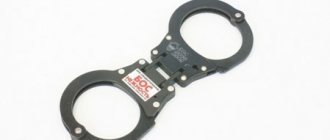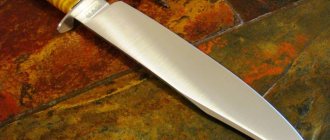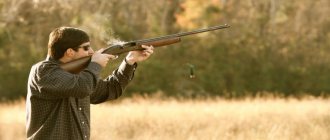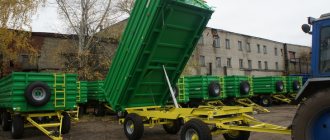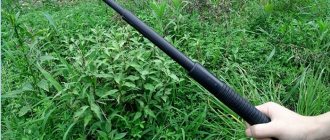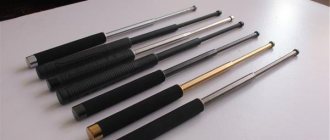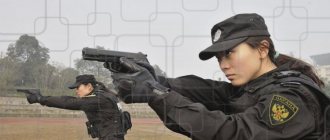I am a taxi driver, do I have the right to carry a police baton in my car?
Based on the norms of the Federal Law of December 13, 1996 No. 150-FZ “On Weapons,” a rubber stick (bludgeon) is not suitable for use as a weapon of impact-crushing objects, but is a special means.
In this regard, given that the procedure for storing and transporting special equipment is not provided for by the current legislation of the Russian Federation, there is no corresponding criminal and administrative liability for storing and transporting a rubber stick (baton) in a car.
We are often asked the question about the legality of purchasing, storing and carrying telescopic batons for self-defense.
Structurally, a telescopic baton is analogous to a conventional baton with the only difference being that in the transport position, due to the possibility of folding, it has a shorter length and, as a result, takes up less space, allowing for concealed carrying.
We are often asked the question about the legality of purchasing, storing and carrying telescopic batons for self-defense.
Structurally, a telescopic baton is analogous to a conventional baton with the only difference being that in the transport position, due to the possibility of folding, it has a shorter length and, as a result, takes up less space, allowing for concealed carrying.
Folding batons are most often made in the form of two- or three-legged telescopes (where each part, when folded, is placed at the end inside the other part. The mechanisms for unfolding batons (bringing them into working condition) also differ - due to inertia or due to a spring ejection mechanism, it is also possible a combination of these two methods.The presence of a flexible last knee (in the form of a tight spring with a weighting agent at the end) equates such a telescopic baton to a flail (a weapon where the impact-crushing part is hinged or loosely attached to the base-handle).
The current version of the Federal Law “On Weapons” (Article 6, paragraph 1) prohibits the circulation of telescopic batons, classifying them as impact-crushing objects:
Article 6. Restrictions established on the circulation of civilian and service weapons
The following are prohibited on the territory of the Russian Federation:
1) circulation as civilian and service weapons:
flails, brass knuckles, shurikens, boomerangs and other objects of impact, crushing and throwing action specially adapted for use as weapons, with the exception of sports equipment;
Since telescopic batons, related to impact-crushing objects, are not related to sports equipment, their circulation in Russia is prohibited.
Actually, we could put an end to this and write nothing more.
However, you can often find telescopic batons on sale. Moreover, they are sold not by gun stores, which also sell licensed goods, but by online stores, individual entrepreneurs and private owners. Taking into account the ban on the sale of telescopic batons as bladed weapons with shock-crushing action, these sellers must violate Art. 22 of the Criminal Code of the Russian Federation. However, not all telescopic batons are melee weapons. Many of them even have a certificate of conformity indicating the household purpose of these items as a product structurally similar to a weapon. Why is that?
The answer is both simple and complex. What if, for example, the telescopic baton is made entirely of, say, aluminum or plastic? Its specific gravity is not high; the force applied by the blow does not exceed the energy of 0.5 J/mm2. That is, such a baton cannot be recognized as a cold weapon with shock-crushing action. Or a telescopic baton is all made of heavy metal, decent in weight, but when energy of 0.5 J/mm2 and above is transferred to the body, it breaks (fragments, bends, etc.).
Such products can easily receive a certificate of a product structurally similar to a weapon.
However, the issue of purchasing and wearing such products, which are essentially toys, for self-defense purposes is controversial. If you rely not only on the spectacular appearance of a telescopic baton, then the effect of use will be the opposite of the desired one - such products will not withstand a serious blow.
And those that can withstand it will already be classified as melee weapons with shock-crushing action. Forensic examination can determine whether a particular telescopic baton belongs to a bladed weapon.
If a telescopic baton is identified as a bladed weapon, it means a violation of Art. 223 of the Criminal Code of the Russian Federation, and for the seller, Article 222 of the Criminal Code of the Russian Federation. That is, the manufacture and sale of bladed weapons is a criminal offense. The owner of such a product (if the fact that the baton was manufactured by the owner himself is not established) faces a maximum fine under Article 20.8 of the Code of Administrative Offenses of the Russian Federation (and then only due to seizure while wearing).
However, the use of a telescopic baton for self-defense, which was later recognized by an examination of cold steel weapons with impact-crushing action, will be an aggravating circumstance with all possible unpleasant consequences for the owner of the product.
A self-defense baton is one of the most ancient types of weapons that has been used by man since time immemorial. Naturally, modern specimens have undergone significant changes, becoming stronger, more compact and more convenient to use. However, the principle of their use remains unchanged. Today, many means of self-defense have been developed, but the baton, due to its simplicity, remains in great demand. This remedy is especially popular among people who know the basics of martial arts.
Issue No. 32 Are telescopic batons legal?
However, you can often find telescopic batons on sale. Moreover, they are sold not by gun stores, which also sell licensed goods, but by online stores, individual entrepreneurs and private owners. Taking into account the ban on the sale of telescopic batons as bladed weapons with shock-crushing action, these sellers must violate Art. 22 of the Criminal Code of the Russian Federation. However, not all telescopic batons are melee weapons. Many of them even have a certificate of conformity indicating the household purpose of these items as a product structurally similar to a weapon. Why is that?
If a telescopic baton is identified as a bladed weapon, it means a violation of Art. 223 of the Criminal Code of the Russian Federation, and for the seller, Article 222 of the Criminal Code of the Russian Federation. That is, the manufacture and sale of bladed weapons is a criminal offense. The owner of such a product (if the fact that the baton was manufactured by the owner himself is not established) faces a maximum fine under Article 20.8 of the Code of Administrative Offenses of the Russian Federation (and then only due to seizure while wearing).
Effective techniques for protecting yourself with a rubber stick
To use a rubber baton as a weapon of self-defense, security guards undergo special training. Its task is to effectively use the advantages of this special tool. They are based on swinging strikes to the limbs of attackers or detainees in combination with the correct movement of a security officer. Practice shows that the most favorable situations in which to strike with a rubber stick are the following:
- the enemy clearly intends to attack and does not expect a counterattack;
- the offender tries to remove a weapon or other dangerous object from his clothing;
- the attacker's armed hand is in a disadvantageous position for his attack;
- the person being detained or the attacker makes a swing.
Trained guards take into account the inertia of the rubber stick, the ability to maneuver when using it, as well as other important features.
To place an order for the provision of security services in Moscow, St. Petersburg and Krasnodar, you can order a call back from our specialist.
Request a call back
Telescopic baton what a punishment
The current version of the Federal Law “On Weapons” (Article 6, paragraph 1) prohibits the circulation of telescopic batons, classifying them as impact-crushing objects: Article 6. Restrictions established on the circulation of civilian and service weapons On the territory of the Russian Federation the following is prohibited: 1) circulation in as civilian and service weapons: flails, brass knuckles, shurikens, boomerangs and other objects of impact-crushing and throwing action specially adapted for use as weapons, with the exception of sports equipment; Since telescopic batons related to objects of impact-crushing action are not related to sports equipment, their circulation in Russia is prohibited. However, telescopic batons can often be found on sale. Moreover, they are sold not by gun stores, which also sell licensed goods, but by online stores, individual entrepreneurs and private owners.
Contents “Is the telescopic baton prohibited or not?” is a question that many people ask themselves who want to acquire such an item for self-defense purposes. After all, if such an item cannot be carried with you, then any patrol can prosecute its owner if he is stopped on the street or in any public place.
The starting position for the strike is a fighting stance, the hand with the rubber stick is lowered down. With the step of the right foot, a swing is made towards the left shoulder, while the body twists as much as possible to the left. With a reverse turn of the body, a backhand blow is struck with a stick at the enemy. The starting position for the next blow is taken with the left foot stepping forward.
This multifunctional design is actively used in the armed forces, police forces and other law enforcement agencies. A hardened telescopic baton is almost a mandatory attribute of a professional as a means of self-defense.
Rubber stick for a security guard: general description
A rubber stick (baton) is a special security device used for active defense. According to the legislation of the Russian Federation, it is included in the ammunition of police officers and private security guards. Rubber batons are used for self-defense when repelling an attack, as well as when detaining an intruder who offers physical resistance.
The structure of the rubber baton is a molded rod made by vulcanization. At one end there is a handle with a lanyard. Some models of the rubber stick use an additional perpendicular handle. This variety is designed in the likeness of the tonfa, a traditional bladed weapon used in martial arts.
Rubber sticks, like other special security equipment (for example, handcuffs) are an integral part of ammunition. Therefore, special hard cases or rings attached to the belt are used to carry them. You can obtain more detailed information on the characteristics of rubber batons from our specialists by filling out an application for the provision of security services.
Order physical security
Are telescopic batons legal and what are the penalties for wearing them?
1. Illegal acquisition, transfer, sale, storage, transportation or carrying of firearms, their main parts, ammunition (except for civilian smooth-bore, its main parts and ammunition), explosives or explosive devices - is punishable by restriction of freedom for a term of up to three years, or arrest for a term of up to six months, or imprisonment for a term of up to four years with a fine in the amount of up to eighty thousand rubles or in the amount of wages or other income of the convicted person for a period of up to three months, or without it.
You may like => Smolensk Benefits for WWII Veterans
4. Illegal sale of gas weapons, cold steel, including throwing weapons - is punishable by compulsory labor for a term of one hundred eighty to two hundred and forty hours, or correctional labor for a term of one to two years, or arrest for a term of three to six months, or imprisonment for a term of up to two years with a fine in the amount of up to eighty thousand rubles or in the amount of wages or other income of the convicted person for a period of up to six months, or without it.
Illegal sale of civilian firearms smooth-bore long-barreled weapons, firearms of limited destruction, gas weapons, edged weapons, including throwing weapons - It is not possible to talk about the use without a specific fact.
establishes: that on the territory of the Russian Federation it is prohibited to use flails, brass knuckles, shurikens, boomerangs and other objects of shock-crushing and throwing action specially adapted for use as weapons, with the exception of sports equipment and the specified objects of cultural value and used in cultural and educational purposes; 2. Can I carry a telescopic baton with me?
Device structure
An elastic and rather long baton is cast from rubber mass in a mold using vulcanization. Inside there is an embedded element that increases elasticity. The handle is quite rigid and dense, there are holes in it where a lanyard is inserted - a loop of nylon or leather one centimeter wide. The loop can be adjusted according to your hand.
To carry a rubber stick on a belt, there is a special device made of belts with a fastening ring.
They carry a baton on the side opposite the firearm.
The video below shows the use of a rubber stick PR 73, which received positive reviews from employees of the Ministry of Internal Affairs:
Fine When Carrying a Telescopic Baton
Specialists from the VNIISE of the Ministry of Justice of the Russian Federation hold a different position. On November 23, 1992, VNIISE of the Ministry of Justice of Russia issued a written consultation on the issue under consideration (? 0139/6-7). It indicated that folding (telescopic) flails belong to police folding spring sticks, i.e. to the category of special means of law enforcement agencies, and they are not edged weapons.
You're right, there is such a thing. The last name has nothing to do with it, but it’s very specific, which is why I asked. And the topic you raised is actually not telescopic batons are definitely recognized as edged weapons if they are made of metal. regardless of whether they are rigid or spring. in principle, weight matters, but for those batons that are sold in Moscow it is quite suitable. I won’t say anything about the reasons why they are being sold. You can, of course, spend a long time absorbing various manuals and works on criminology and weapons science, but to be honest, I was immersed in such subtleties when I was studying. in practice everything is simpler and faster. what to talk about?
Legal regulation of the use of rubber sticks
Currently, the wearing and use of rubber police batons is permitted for private security personnel who have undergone appropriate training and have a 4, 5 or 6 rank security guard. The use of this category of special security equipment is permitted when repelling an attack that directly threatens the life and health of a security guard. Also, a security guard’s rubber stick is acceptable for use in cases where violators resist arrest.
The law stipulates that the use of such special equipment as a rubber truncheon is permissible only in situations where non-violent methods (prevention) have failed. At the same time, hitting with a rubber truncheon by a security guard is prohibited against women with visible signs of pregnancy, disabled people and minors. The only exceptions here can be those cases when the attacker or detainee offers armed resistance, as well as in cases of a group attack on a security officer.
Telescopic baton: how legal is it?
It is impossible to talk about application without concrete fact. It is possible to qualify an act according to its consequences (depending on the severity of bodily injury) taking into account the circumstances of its use. But having a bladed weapon with you and using it will not be in your favor. For self-defense, other means of protection are commercially available. Melee weapons are rather weapons not for self-defense, but for attack, and therefore carrying them is prohibited. If found, it will be confiscated.
You may like => Housing and Utilities Subsidies for Pensioners Documents Provide
The tubes must be of different sizes, since one fits into the other. In addition, you will need a lock that is installed on a larger diameter pipe. An iron flat plate can act as a lock. It should be borne in mind that the better and stronger the material, the more reliable the product will be and the longer the baton will last during use.
ESP telescopic batons from the Czech Republic have gained good reviews and popularity in Russia. The online store of defense equipment of the Czech company ESP offers a wide selection of Czech high-quality metal telescopic batons of hardened (for police) and non-hardened versions, as well as accessories for them.
Regarding the TS issue, I think everything is very simple. Whether a given particular sample belongs to a bladed weapon or not is decided by an examination (a product certificate and/or information sheet is usually made by the manufacturer or importer). If there is no certificate, then an examination must be carried out upon seizure, and then where the curve will lead.
In general, everything is completely similar to knives, there are knives - edged weapons, there are household knives, the difference is determined by the examination, which is usually carried out by the manufacturer or importer. I think a private person can take care of this at his own expense, but most likely it will be expensive and hemorrhagic, especially if chemical weapons are recognized.
How to use
As if lengthening the arm, the rubber baton is capable of distancing the owner from the enemy. It is better to attack in a fighting stance - right or left. In this case, the stick is held with one or two hands (holding both ends). When attacking, it is better to take a side stance.
Swinging and thrusting blows can be applied to the limbs and torso, and the blow can be lateral, upper or lower. You cannot hit the head, neck, genitals, or collarbones. The consequences can be disastrous, even death (if hit in the temple). We separately describe in more detail the tactics of fighting with a baton.
Reviews and prices for the rubber baton (rubber stick) PR 73 (including model M) are discussed below.
Are telescopic batons legal and what are the penalties for wearing them?
Currently, in the CIS countries, the presence of telescopic batons in free access to the civilian population is prohibited. The reason for this is the classification of such weapons, because these are cold weapons with crushing destructive effects. Therefore, domestic users who need means for self-defense often resort to using homemade batons.
However, such products are often used by civilians as highly effective bladed weapons for self-defense, although this is prohibited. The ESP telescopic baton, like devices from other reputable brands, has an intuitive action. Dealing with such a weapon in case of danger is not difficult compared to the same gas canister and stun gun, which need to be aimed at the enemy. Such tools have a well-balanced balance between the whip and the handle, making them extremely convenient to use.
Within the framework of the Federal Law “On Weapons”, a telescopic baton falls into the category of edged weapons with impact-crushing action, although it is not directly mentioned there. If a dispute arises about whether a particular item belongs to the category of weapon, it is ultimately resolved by an expert. His conclusion will be a convincing argument for law enforcement officials. MUK No. 1 specialists will help organize an examination and pose really important questions to the expert that will confirm the client’s position.
There are quite a lot of types of weapons, and not all of them are listed in the legislation. But all objects that can be considered weapons have one thing in common: they are initially created with the purpose of hitting a living target. And the telescopic baton is no exception. Its manufacturer emphasizes that such an item is easy to wear, because it is lightweight. In addition, the telescopic baton is invisible under clothing due to its technical characteristics that allow it to be folded. But it is used specifically to cause damage.
Rubber stick for protection: several historical facts
The use of rubber sticks in private security activities in Russia was introduced in 1992. However, the first attempts to introduce such special equipment into the practice of security agencies were made much earlier. In 1881, the Minister of the Ministry of Internal Affairs, Ignatiev, turned to the emperor for permission to arm the police with wooden clubs, which were already in use at that time in a number of European countries.
If at that time the refusal occurred due to the ruler’s great humanity, then on the eve of the 1917 revolution the emperor refused a new appeal for a different reason. This time, police batons turned out to be inappropriate, since more effective weapons had to be used to pacify the riots. Attempts were repeated several times during the USSR. However, under the totalitarian Stalinist regime there was no such need. Therefore, it was only in 1962 that a resolution was adopted on the wearing of rubber truncheons by police officers.
For security guards of private services, such permission was given in 1992. For more than a quarter of a century, legislation in this area has changed significantly. At the same time, the main one here was and remains the Federal Law “On private detective and security activities in the Russian Federation” with numerous amendments. This document regulates the use of rubber batons, and also determines the types of this special equipment permitted for use by private security guards.
Telescopic baton what a punishment
Question What threatens me? February 10, 2022, 09:58, question No. 1533742 Mikhail, Krasnoyarsk Collapse Online legal consultation Response on the site within 15 minutes Answers from lawyers (2) 286 answers 82 reviews Chat Free assessment of your situation Lawyer, St. Petersburg Free assessment of your situation Hello, Mikhail!
You may like => VPD Military Personnel In 2022 On The Train
Such tools have a well-balanced balance between the whip and the handle, making them extremely convenient to use. The design of most telescopic devices for self-defense involves the use of several composite cylinders that can be nested into each other.
Communities › DRIVE2 and traffic police › Blog › The gays will take away such a thing
In general, after the video on the confiscation of baseball bats, the question arose - Will the flashlight and key also be taken away? This is not a baseball bat!
Here, for example, is the description of the 2nd picture Flashlight baton Police BL-B90 rechargeable - The body of the flashlight is made of high-quality anodized aluminum (scratch-resistant coating). As batteries for the flashlight, you can use either a 18650 lithium battery (included in the kit) or three AAA batteries/batteries. It has three operating modes (switching by lightly pressing the power button). It will be an original and necessary gift for men, as it will be useful both for self-defense and for bright mobile lighting. Main parameters: weight 900g, length 44cm, diameter of the thickest part 13cm.
Light source (LED): 1 LED - Cree. Light beam range: 800 meters. Digital current stabilization: yes. Reflector material: high-quality aluminum. Housing finish: anodized, scratch-resistant. Button: at the end of the case Number of operating modes: 3 (Bright > Dim > Strobe) Batteries: 1 x 18650 lithium battery or 2 x AAA batteries/batteries Delivery set: 1) Flashlight bit. 2) Charger. 3) 18650 lithium battery 3800ma.4) Adapter for 3xAAA batteries/accumulator.
You may like => Age at which a person is considered a minor in the Russian Federation
Is a telescopic baton for self-defense prohibited or not?
Since carrying a long metal or rubber stick with you would be inconvenient, batons for self-defense began to be made collapsible. The telescopic baton consists of several cylinders of different diameters that fit perfectly together. This design operates on the principle of a telescope, when another part extends from one part, and consists of the following elements:
Therefore, wearing a “telescope” of any design may raise unwanted questions from law enforcement officers, since this tool, like nunchucks, for example, is considered an object that is originally intended to cause bodily harm to a person. However, “telescopes” are sold in the markets, and you can also buy a telescopic baton via the Internet.
- Materials. As mentioned above, there are steel and plastic models. The former are more dangerous, so to avoid negative consequences it is better to give preference to structures made of durable plastic.
- Dimensions. The more compact the baton when folded, the better. The average size of a baton when unfolded reaches 35-40 cm. There are models with a longer length, but according to experts, a medium-sized baton is the optimal weapon for fighting an attacker.
- Comfortable to wear. In addition to the possibility of concealed carrying, the baton must be located in such a way that it can be quickly and easily removed if necessary. Therefore, many batons are sold in special cases that are fastened to the belt. This holster can be purchased separately.
When folded, this design can be worn over a waist belt or carried in the glove compartment of a car. At the same time, it only takes a couple of seconds for such a product to turn into a powerful cane, capable of becoming a formidable weapon against intruders at any moment.
Which model is better?
To understand this issue, you should consider each design in more detail:
- A plastic baton is the cheapest self-defense option. It consists of two sections. The section with the handle is hollow, and the striking part is filled with special rubber, which adds weight to the structure. The average length when unfolded is 40-50 cm, when folded - 20-30 cm. This is the optimal means of self-defense for beginners, since it is simple in design and has a sufficient damaging effect.
- Rubber batons for self-defense are elastic, which ensures good whiplash properties. Such products are monolithic and are often used by law enforcement officers. The average length ranges from 40-55 cm. They are available in two versions: with an ergonomic or sliding handle.
- Steel models are the most reliable. They are made of hardened steel, which means they do not deform even when in contact with concrete walls. They have impressive lethality. They may involve both rigid fixation of elements and free movement. The last option is considered the most traumatic.
Is it possible to carry a telescopic baton in Russia?
Folding batons are most often made in the form of two- or three-legged telescopes (where each part, when folded, is placed at the end inside the other part. The mechanisms for unfolding batons (bringing them into working condition) also differ - due to inertia or due to a spring ejection mechanism, it is also possible a combination of these two methods.The presence of a flexible last knee (in the form of a tight spring with a weighting agent at the end) equates such a telescopic baton to a flail (a weapon where the impact-crushing part is hinged or loosely attached to the base-handle).
- Handles. As a rule, the handle is rubber, which ensures a secure hold in your hands.
- The retractable parts - cylinders - that extend from the handle and unfold to the desired size will lock tightly and securely in the resulting position.
- As a rule, the baton kit includes a special case with which you can attach the baton to your belt.
26 Apr 2022 polrostov 226
Share this post
- Related Posts
- Got Married at 14
- Should a woman work in hazardous work?
- Characteristics of Relationships in the Family of the Patient
- Service Checking Fines Using Passport
Types of rubber sticks in modern security activities
The current legislation of the Russian Federation establishes the following types of rubber sticks permitted for use by employees of private security services and organizations:
- PR-73 is a universal model of straight shape and with standards of 700 mm/30 mm/700 g (length/diameter/weight). In recent years, a modified PR-73M rubber baton, equipped with a ring protrusion (mini-guard) on the handle, is more often used.
- PR-K (PR-Kontakt) is a shortened straight model with parameters 465/31/600. The model is considered more convenient when used in cramped conditions, where the risk of injury to third parties increases.
- PR-T (PR-Taran) - a rubber stick with a side handle and technical characteristics 565/30/750. This tonfa is extremely comfortable to use and wear. In addition, the impressive size of the PR-T produces a deterrent effect.
- PUS-1 “Argument” is a special universal stick, manufactured in lengths of 480 or 650 mm. The design feature of this model is the presence of a plastic shield that protects the hand.
- PUS-2 "Argument-M" / "Argument-B" - an analogue of PUS-1, equipped with an additional perpendicular handle. This model of a rubber stick significantly increases the advantage of security officers over attackers or detainees.
- PUS-3 “Argument” is a universal telescopic rubber stick that provides maximum wearing comfort. The length of the model when folded is 300 mm, and when working it is 600 mm.
The choice of a suitable model depends on the specifics of the security services provided by private security company employees.
